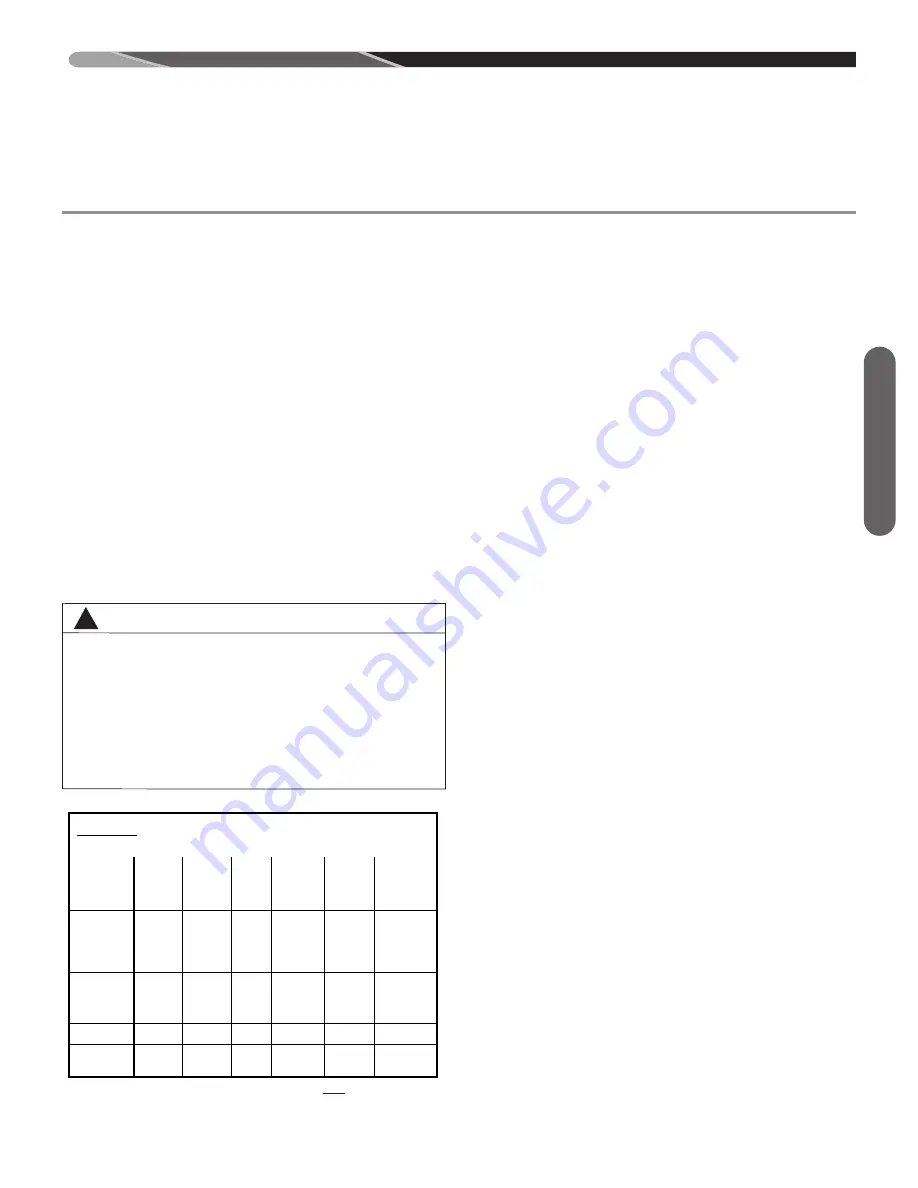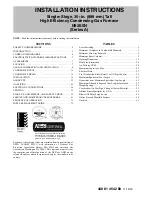
47
5. The minimum vent pipe length is 5 feet [1.5m].
6.
IMPORTANT:
No part of the combustion air and/or vent
pipes may be installed underground.
7. Piping at a roof, wall or other penetration must be im-
mobilized to prevent pipes from disconnecting. Discon-
nected pipes may allow flue products to be released
inside the structure.
8. For Direct Vent systems, all pipe penetrations through
roof or sidewall must be installed so that the vent and
combustion air intake pipes terminate in the same at-
mospheric pressure zone.
9. Vent terminations must be installed with the minimum
clearances specified in the TERMINATION REQUIRE-
MENTS sections of this manual and
Figure 21
(for
Non-Direct Vent) and
Figure 32
(for direct Vent instal-
lations).
10. Piping external to the structure (excluding approved
venting terminations) and vent passing through un-
heated crawl-spaces, attics, verandas, patios or decks
must be insulated with approved insulating material to
prevent freezing as required for local climate.
JOINING PIPE AND FITTINGS
All pipe, fittings, solvent cement, primers and procedures
must be installed following the vent manufacturer’s installa-
tion instructions and must conform to American National
Standards Institute and American Society for Testing Mate-
rials (ANSI/ASTM) standards as shown in the
Table 2
below:
CEMENTING JOINTS
Properly seal all joints in the PVC vent using the following
materials and procedures.
PVC CLEANER-PRIMER AND PVC
MEDIUM-BODY SOLVENT CEMENT
IMPORTANT:
After cutting pipe, remove all ragged edges
and burrs. This is important to prevent reduction in pres-
sure drop throughout the system.
1. Cut pipe end square. Chamfer edge of pipe. Clean fit-
ting socket and pipe joint area of all dirt, grease and
moisture.
2. After checking pipe and socket for proper fit, wipe
socket and pipe with cleaner-primer. Apply a liberal
coat of primer to inside surface of socket and outside of
pipe. Read instructions included with the primer for
proper application.
3. Apply a thin coat of cement evenly within the socket.
Quickly apply a heavy coat of cement to the pipe end
and insert pipe into the fitting with a slight twisting
movement until it bottoms out.
NOTE:
Cement must be fluid. If not, re-coat.
4. Hold the pipe in the fitting for 30 seconds to prevent the
tapered socket from pushing the pipe out of the fitting.
5. Wipe all excess cement from the joint with a rag. Allow
15 minutes before handling. Cure time varies accord-
ing to fit, temperature and humidity.
NOTE:
Stir the solvent cement frequently while using. Use
a natural bristle brush or the dauber supplied with the can.
The proper brush size is one inch.
IMPORTANT:
For proper installation:
DO NOT
use solvent cement that has become curdled,
lumpy or thickened.
DO NOT
thin. Observe shelf precautions printed on
containers. For applications below 32°F, use only low-
temperature type solvent cement.
VENTING & COMBUSTION AIR REQUIREMENTS (cont.)
GENERAL VENTING REQUIREMENTS AND
GUIDELINES
% $
12345167
89
(
5:3
5:3
366
;43
5:3 $5225<=7 45>34
;6?
3>3<2
"6$
!/%.>
*@.?
!.9@?
A
!.@@/
!..&%
('
!/>?% !..9/ *?=/
!.9@@
A
!.@@%
*@%@
!.%@9
'('
*99/
*99.
*&9?
*9=&
"6$
('
!&/&?
For Canadian installations all exhaust venting materials must be certified to
ULCS-636C.
(U.S. Only)
!
WARNING
PVC/CPVC SOLVENT CEMENTS AND PRIMERS
ARE HIGHLY FLAMMABLE. PROVIDE ADEQUATE
VENTILATION AND DO NOT ASSEMBLE NEAR A
HEAT SOURCE OR AN OPEN FLAME. DO NOT
SMOKE. AVOID SKIN OR EYE CONTACT. OB-
SERVE ALL CAUTIONS AND WARNINGS PRINTED
ON MATERIAL CONTAINERS. FAILURE TO FOL-
LOW THESE GUIDELINES MAY RESULT IN FIRE,
EXPLOSION OR ASPHYXIATION CAUSING PER-
SONAL INJURY OR DEATH.
Ve
nting
Summary of Contents for 92MSP SERIES
Page 34: ...34 Field Conversions ...
Page 35: ...35 Field Conversions ...
Page 36: ...36 Field Conversions ...
Page 37: ...37 Field Conversions ...
Page 38: ...Field Conversions 38 ...
Page 99: ...99 ...
Page 100: ...100 CM 0716 ...
















































